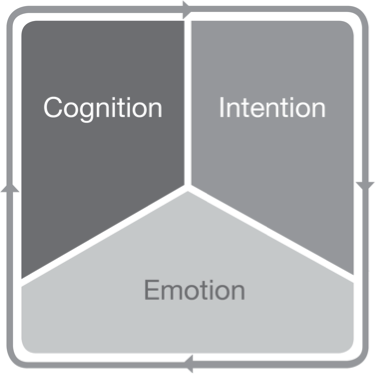Integrated Learning
Integrated learning is learning in which intention, emotion, and cognition are wholly connected.
- L intends to learn,
- L feels good about learning, and
- L increases complexity of mental structures (i.e., L learns),
where L is a learner.

Figure 1. Drawing of integration of cognition, intention and emotion by Colin Gray. The wholeness is indicated by the conjoining of the 3 shapes (components with different shades of gray) that comprise the rounded square shape. The outer path with arrows further indicate the wholeness, where each component affects all other components. A digraph (Thompson, 2008b, p. 8) would be another way to represent this relationship.
See also: integrated knowing.
Greenspan and Benderly (1997) have noted that since the ancient Greek philosophers, the rational or cognitive aspect of mind has often been viewed as developing separately from emotion. They argue that this view has blinded us to the role of emotion in how we organize what we have learned: “In fact, emotions, not cognitive stimulation, serve as the mind’s primary architect” (p. 1). They identify the importance of emotion during human experience: “… each sensation … also gives rise to an affect or emotion…. It is this dual coding of experience that is the key to understanding how emotions organize intellectual capacities …” (p. 18).
See also Democracy and education, Chapter 11: Experience and Thinking, by John Dewey (1916).
Dewey was very clear about the relation between the will (intention) and intellect (cognition):
Thinking, in other words, is the intentional endeavor to discover specific connections between something we do and the consequences which result… (p. 145, italics added)
Experience as trying involves change, but change is meaningless transition unless it is consciously connected with the return wave of consequences which flow from it. When an activity is continued into the undergoing of consequences, when the change made by action is reflected back into the change made in us, the mere flux is loaded with significance. We learn something. (p. 139, italics added)
Experience is primarily an active-passive affair; it is not primarily cognitive. But … the measure of the value of the experience lies in the perception of relationships or continuities to which it leads up. It includes cognition in the degree in which it is cumulative or amounts to something, or has meaning. (p. 140, italics added)
Although Dewey did not explicitly realize the role of emotion in the creation of mental structures, he was aware of the lack of integration of real purpose in learning in school and what is expected to be learned. He argued that purposeful experience was important in order to make student learning more meaningful. Even in his time, nearly a century ago, many students were bored with what appeared to be meaningless subject matter—as are many students in school today.
